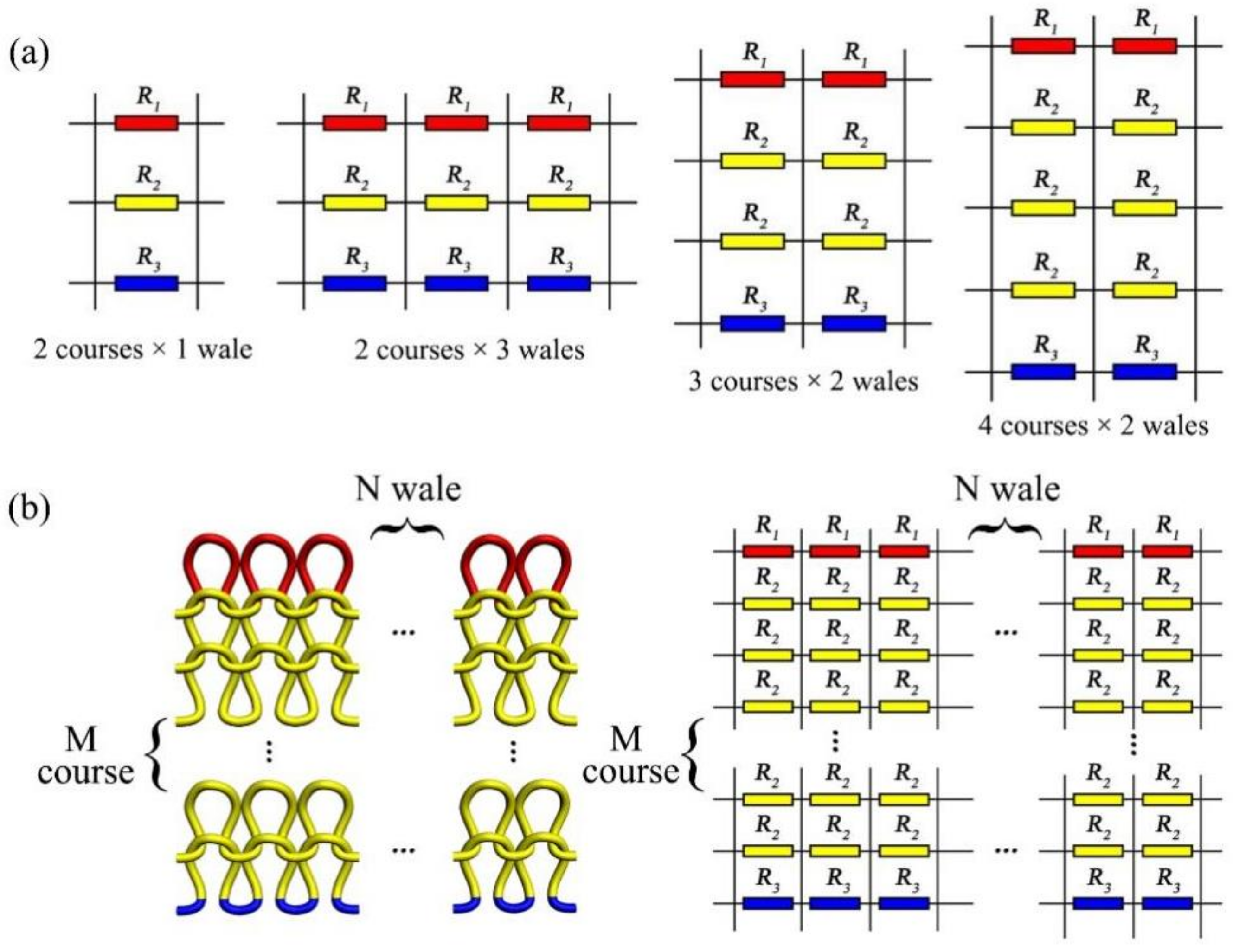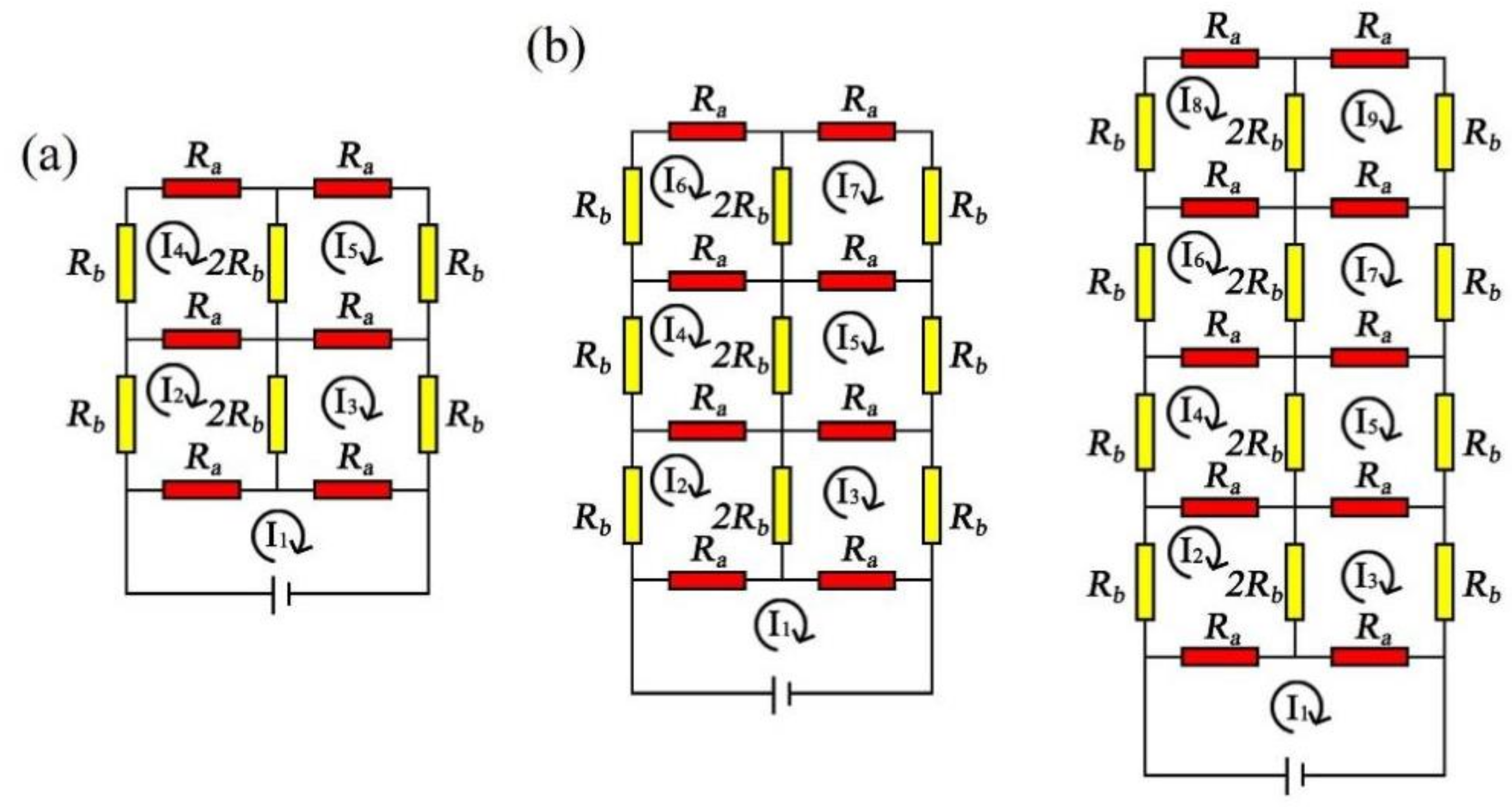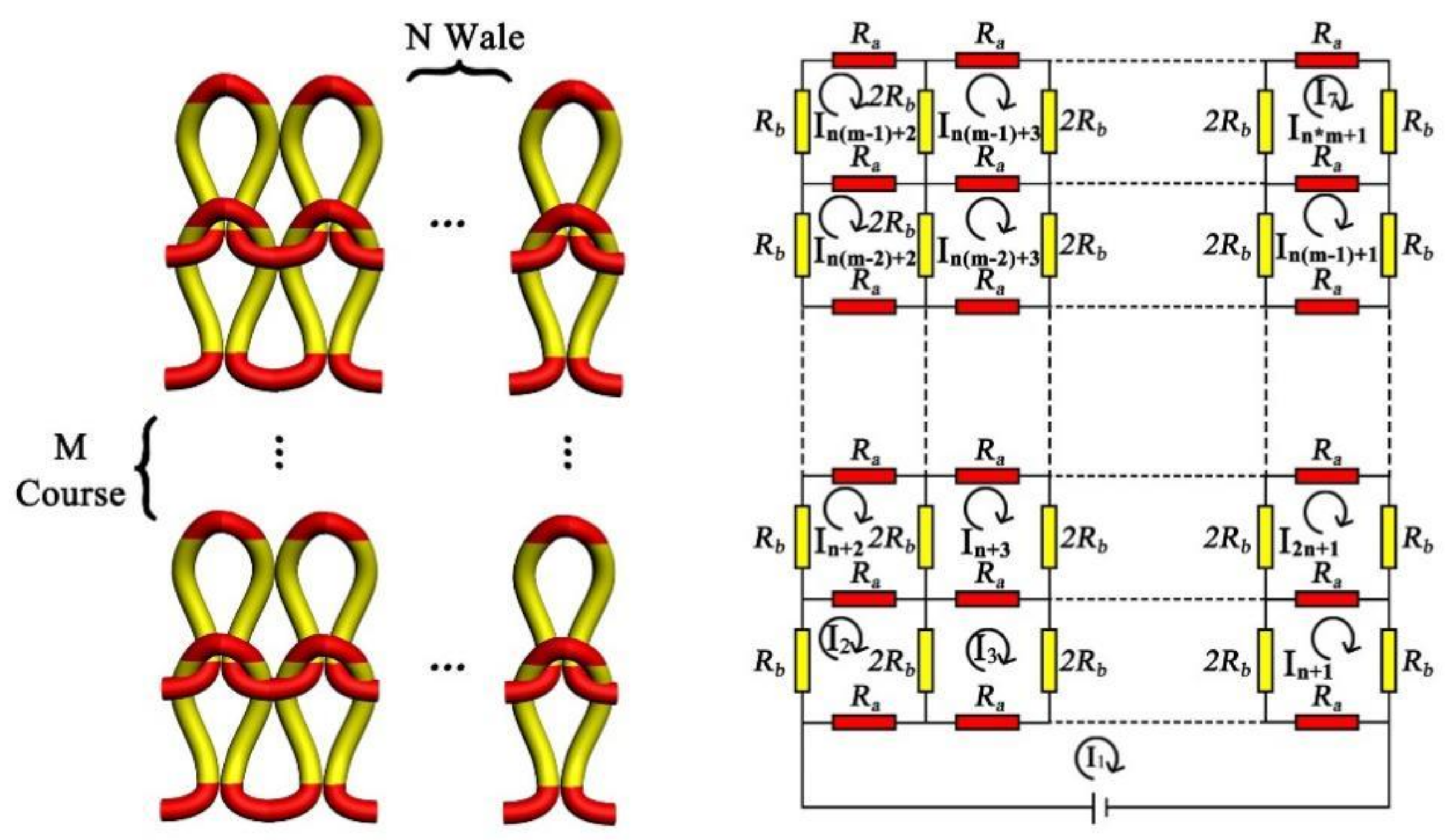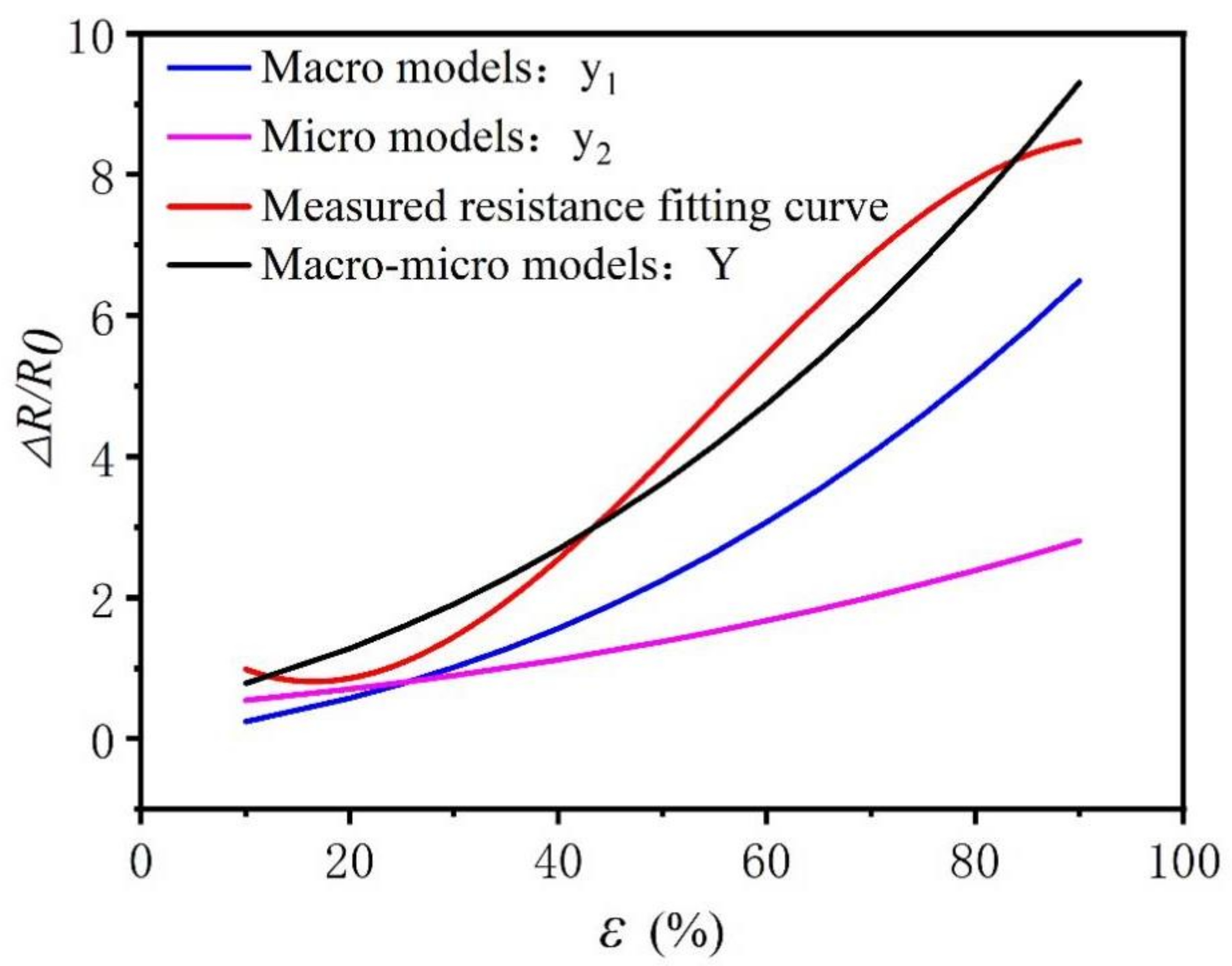Dynamic Equivalent Resistance Model of Knitted Strain Sensor under In-Plane and Three-Dimensional Surfaces Elongation
Abstract
:1. Introduction
2. Materials and Methods
2.1. Materials
2.2. Sensing Performance Test
2.3. Theoretical Model
- (1)
- In the unstretched state, fabric loops are tightly abutted, and the resistance of the circuit is low. When subjected to longitudinal stretching, according to the law of resistance as given in Equation (1), the overall circuit resistance increases due to the length change.where is the proportionality constant and known as the resistivity or the specific resistance of the material of the conductor or substance; is the length of the substance; is the cross-sectional area of the substance.
- (2)
- When the force is stretched until loops are separated from each other, the resistance is constant at the maximum value.
- (3)
- When the fabric continues to be stressed, according to the contact resistance [23,24] theory as given in Equation (2), the contact pressure between the loops increases and the resistance decreases.where (), (), , and () are the electrical resistivity, material hardness, number of contact points, and contact pressure between the conductive yarn, respectively.
2.4. Model 1: Macro–Micro Equivalent Resistance Models Based on Length Resistance
2.5. Model 2: The Equivalent Resistance of the Knitted Sensor Based on the Topology Model
2.6. Model 3: The Equivalent Resistance of the Knitted Sensor Based on the Topology Model
3. Results
3.1. Calculation of the Macro–Micro Equivalent Resistance Model Based on Length Resistance
3.2. Calculation of the Equivalent Resistance Based on the Topology Model
3.3. Calculation of the Equivalent Resistance Model Based on the Three-Dimensional Curved Surface Strain
3.4. Fabric Cycle Test Results under In-Plane Stretching
3.5. Comparison of the Experimental Data and the Equivalent Resistance Model Calculation Results during In-Plane Stretching
3.6. Comparison of the In-Plane Tensile Test Results and the Equivalent Resistance Calculation Results of the Topology Model
3.7. Comparison of Three-Dimensional Strain Equivalent Resistance Model and Test Results
4. Conclusions
Author Contributions
Funding
Institutional Review Board Statement
Informed Consent Statement
Data Availability Statement
Acknowledgments
Conflicts of Interest
References
- Jakubas, A.; Łada-Tondyra, E. A Study on Application of the Ribbing Stitch as Sensor of Respiratory Rhythm in Smart Clothing Designed for Infants. J. Text. Inst. 2018, 109, 1208–1216. [Google Scholar] [CrossRef]
- Jost, K.; Durkin, D.P.; Haverhals, L.M.; Brown, E.K.; Langenstein, M.; De Long, H.C.; Trulove, P.C.; Gogotsi, Y.; Dion, G. Natural Fiber Welded Electrode Yarns for Knittable Textile Supercapacitors. Adv. Energy Mater. 2015, 5, 1401286. [Google Scholar] [CrossRef]
- Babu, V.J.; Anusha, M.; Sireesha, M.; Sundarrajan, S.; Abdul Haroon Rashid, S.S.A.; Kumar, A.S.; Ramakrishna, S. Intelligent Nanomaterials for Wearable and Stretchable Strain Sensor Applications: The Science behind Diverse Mechanisms, Fabrication Methods, and Real-Time Healthcare. Polymers 2022, 14, 2219. [Google Scholar] [CrossRef] [PubMed]
- Chen, Q.; Shu, L.; Zheng, R.; Fu, B.; Fan, J. Electrical Resistance of Stainless Steel/Polyester Blended Knitted Fabrics for Application to Measure Sweat Quantity. Polymers 2021, 13, 1015. [Google Scholar] [CrossRef] [PubMed]
- Wang, J.; Lu, C.; Zhang, K. Textile-Based Strain Sensor for Human Motion Detection. Energy Environ. Mater. 2020, 3, 80–100. [Google Scholar] [CrossRef] [Green Version]
- Agcayazi, T.; Chatterjee, K.; Bozkurt, A.; Ghosh, T.K. Flexible Interconnects for Electronic Textiles. Adv. Mater. Technol. 2018, 3, 1700277. [Google Scholar] [CrossRef]
- Zhou, X.; Hu, C.; Lin, X.; Han, X.; Zhao, X.; Hong, J. Polyaniline-Coated Cotton Knitted Fabric for Body Motion Monitoring. Sens. Actuators A Phys. 2021, 321, 112591. [Google Scholar] [CrossRef]
- Luo, Y.; Verpoest, I. Biaxial Tension and Ultimate Deformation of Knitted Fabric Reinforcements. Compos. Part A Appl. Sci. Manuf. 2002, 33, 197–203. [Google Scholar] [CrossRef]
- Isaia, C.; McNally, D.S.; McMaster, S.A.; Branson, D.T. Effect of Mechanical Preconditioning on the Electrical Properties of Knitted Conductive Textiles during Cyclic Loading. Text. Res. J. 2019, 89, 445–460. [Google Scholar] [CrossRef]
- Zhang, X.; Zhong, Y. An Improved Theoretical Model of the Resistive Network for Woven Structured Electronic Textile. J. Text. Inst. 2020, 111, 235–248. [Google Scholar] [CrossRef]
- Zhao, Y.; Li, L. A Simulation Model of Electrical Resistance Applied in Designing Conductive Woven Fabrics—Part II: Fast Estimated Model. Text. Res. J. 2018, 88, 1308–1318. [Google Scholar] [CrossRef]
- Li, X.; Koh, K.H.; Xue, J.; So, C.H.; Xiao, N.; Tin, C.; Wai, K.; Lai, C. 1D-2D Nanohybrid-Based Textile Strain Sensor to Boost Multiscale Deformative Motion Sensing Performance. Nano Res. 2022, 1–12. [Google Scholar] [CrossRef]
- Xie, J.; Jia, Y.; Miao, M. High Sensitivity Knitted Fabric Bi-Directional Pressure Sensor Based on Conductive Blended Yarn. Smart Mater. Struct. 2019, 28, 035017. [Google Scholar] [CrossRef]
- Wang, J.; Long, H.; Soltanian, S.; Servati, P.; Ko, F. Electromechanical Properties of Knitted Wearable Sensors: Part 1—Theory. Text. Res. J. 2014, 84, 3–15. [Google Scholar] [CrossRef]
- Gioberto, G.; Dunne, L.E. Overlock-Stitched Stretch Sensors: Characterization and Effect of Fabric Property. J. Text. Appar. Technol. Manag. 2013, 8, 3. [Google Scholar]
- Li, W.; Pei, Z. Strain-Sensing Fiber with a Core–Sheath Structure Based on Carbon Black/Polyurethane Composites for Smart Textiles. Text. Res. J. 2021, 91, 1907–1923. [Google Scholar] [CrossRef]
- Liu, S.; Tong, J.; Yang, C.; Li, L. Smart E-Textile: Resistance Properties of Conductive Knitted Fabric—Single Pique. Text. Res. J. 2017, 87, 1669–1684. [Google Scholar] [CrossRef]
- Ehrmann, A.; Heimlich, F.; Brücken, A.; Weber, M.; Haug, R. Suitability of Knitted Fabrics as Elongation Sensors Subject to Structure, Stitch Dimension and Elongation Direction. Text. Res. J. 2014, 84, 2006–2012. [Google Scholar] [CrossRef]
- Liu, S.; Liu, Y.; Li, L. The Impact of Different Proportions of Knitting Elements on the Resistive Properties of Conductive Fabrics. Text. Res. J. 2019, 89, 881–890. [Google Scholar] [CrossRef]
- Vallett, R.; Knittel, C.; Christe, D.; Castaneda, N.; Kara, C.D.; Mazur, K.; Liu, D.; Kontsos, A.; Kim, Y.; Dion, G. Digital Fabrication of Textiles: An Analysis of Electrical Networks in 3D Knitted Functional Fabrics. In Proceedings of the Micro- and Nanotechnology Sensors, Systems, and Applications IX, Anaheim, CA, USA, 9–13 April 2017; Volume 10194, p. 1019406. [Google Scholar]
- Liang, X.; Cong, H.; Dong, Z.; Jiang, G. Size Prediction and Electrical Performance of Knitted Strain Sensors. Polymers 2022, 14, 2354. [Google Scholar] [CrossRef]
- Zhang, Y.; Long, H. Resistive Network Model of the Weft-Knitted Strain Sensor with the Plating Stitch-Part 1: Resistive Network Model under Static Relaxation. J. Eng. Fiber. Fabr. 2020, 15, 1558925020944563. [Google Scholar] [CrossRef]
- Zhang, Y.; Long, H. Resistive Network Model of the Weft-Knitted Strain Sensor with the Plating Stitch-Part 2: Resistive Network Model during the Elongation along Course Direction. J. Eng. Fiber. Fabr. 2020, 15, 1558925020969475. [Google Scholar] [CrossRef]
- Ayodele, E.; Zaidi, S.A.R.; Scott, J.; Zhang, Z.; Hafeez, M.; McLernon, D. The Effect of Miss and Tuck Stitches on a Weft Knit Strain Sensor. Sensors 2021, 21, 358. [Google Scholar] [CrossRef]
- Tajin, M.A.S.; Amanatides, C.E.; Dion, G.; Dandekar, K.R. Passive UHF RFID-Based Knitted Wearable Compression Sensor. IEEE Internet Things J. 2021, 8, 13763–13773. [Google Scholar] [CrossRef]
- Wang, X.; Yang, B.; Li, Q.; Wang, F.; Tao, X. Modeling the Stress and Resistance Relaxation of Conductive Composites-Coated Fabric Strain Sensors. Compos. Sci. Technol. 2021, 204, 108645. [Google Scholar] [CrossRef]
- Zhao, Y.; Tong, J.; Yang, C.; Chan, Y.F.; Li, L. A Simulation Model of Electrical Resistance Applied in Designing Conductive Woven Fabrics. Text. Res. J. 2016, 86, 1688–1700. [Google Scholar] [CrossRef]
- Li, L.; Liu, S.; Ding, F.; Hua, T.; Au, W.M.; Wong, K.S. Electromechanical Analysis of Length-Related Resistance and Contact Resistance of Conductive Knitted Fabrics. Text. Res. J. 2012, 82, 2062–2070. [Google Scholar] [CrossRef]
- Li, L.; Au, W.M.; Hua, T.; Wong, K.S. Design of a Conductive Fabric Network by the Sheet Resistance Method. Text. Res. J. 2011, 81, 1568–1577. [Google Scholar] [CrossRef]
- Veeramuthu, L.; Venkatesan, M.; Benas, J.S.; Cho, C.J.; Lee, C.C.; Lieu, F.K.; Lin, J.H.; Lee, R.H.; Kuo, C.C. Recent Progress in Conducting Polymer Composite/Nanofiber-Based Strain and Pressure Sensors. Polymers 2021, 13, 4281. [Google Scholar] [CrossRef]
- Wang, J.; Long, H.; Soltanian, S.; Servati, P.; Ko, F. Electro-Mechanical Properties of Knitted Wearable Sensors: Part 2—Parametric Study and Experimental Verification. Text. Res. J. 2014, 84, 200–213. [Google Scholar] [CrossRef]
- Tokarska, M.; Orpel, M. Study of Anisotropic Electrical Resistance of Knitted Fabrics. Text. Res. J. 2019, 89, 1073–1083. [Google Scholar] [CrossRef]
- Tokarska, M. Characterization of Electro-Conductive Textile Materials by Its Biaxial Anisotropy Coefficient and Resistivity. J. Mater. Sci. Mater. Electron. 2019, 30, 4093–4103. [Google Scholar] [CrossRef] [Green Version]
- Xie, J.; Long, H. Investigation on the Relation between Structure Parameters and Sensing Properties of Knitted Strain Sensor under Strip Biaxial Elongation. J. Eng. Fiber. Fabr. 2015, 10, 155892501501000. [Google Scholar] [CrossRef]
- Yu, R.; Zhu, C.; Wan, J.; Li, Y.; Hong, X. Review of Graphene-Based Textile Strain Sensors, with Emphasis on Structure Activity Relationship. Polymers 2021, 13, 151. [Google Scholar] [CrossRef] [PubMed]
- Xie, J.; Long, H. Equivalent Resistance Calculation of Knitting Sensor under Strip Biaxial Elongation. Sens. Actuators A Phys. 2014, 220, 118–125. [Google Scholar] [CrossRef] [Green Version]
- Li, L.; Au, W.M.; Wan, K.M.; Wan, S.H.; Chung, W.Y.; Wong, K.S. A Resistive Network Model for Conductive Knitting Stitches. Text. Res. J. 2010, 80, 935–947. [Google Scholar] [CrossRef]
- Yang, K.; Song, G.L.; Zhang, L.; Li, L.W. Modelling the Electrical Property of 1 × 1 Rib Knitted Fabrics Made from Conductive Yarns. In Proceedings of the 2009 2nd International Conference on Information and Computing Science, ICIC 2009, Manchester, UK, 21–22 May 2009; Volume 4, pp. 382–385. [Google Scholar]
- Gioberto, G.; Dunne, L. Theory and Characterization of a Top-Thread Coverstitched Stretch Sensor. In Proceedings of the Conference Proceedings—IEEE International Conference on Systems, Man and Cybernetics, Seoul, Korea, 14–17 October 2012; pp. 3275–3280. [Google Scholar]
- Zhang, H.; Tao, X.; Wang, S.; Yu, T. Electro-Mechanical Properties of Knitted Fabric Made From Conductive Multi-Filament Yarn Under Unidirectional Extension. Text. Res. J. 2005, 75, 598–606. [Google Scholar] [CrossRef]
- Zhang, H.; Tao, X.; Yu, T.; Wang, S. Conductive Knitted Fabric as Large-Strain Gauge under High Temperature. Sens. Actuators A Phys. 2006, 126, 129–140. [Google Scholar] [CrossRef]
- Atalay, O.; Tuncay, A.; Husain, M.D.; Kennon, W.R. Comparative Study of the Weft-Knitted Strain Sensors. J. Ind. Text. 2017, 46, 1212–1240. [Google Scholar] [CrossRef]
- Lin, Z.I.; Lou, C.W.; Pan, Y.J.; Hsieh, C.T.; Huang, C.H.; Huang, C.L.; Chen, Y.S.; Lin, J.H. Conductive Fabrics Made of Polypropylene/Multi-Walled Carbon Nanotube Coated Polyester Yarns: Mechanical Properties and Electromagnetic Interference Shielding Effectiveness. Compos. Sci. Technol. 2017, 141, 74–82. [Google Scholar] [CrossRef]
- Hong, J.; Pan, Z.; Zhewang; Yao, M.; Chen, J.; Zhang, Y. A Large-Strain Weft-Knitted Sensor Fabricated by Conductive UHMWPE/PANI Composite Yarns. Sens. Actuators A Phys. 2016, 238, 307–316. [Google Scholar] [CrossRef]
- Li, Q.; Tao, X. A Stretchable Knitted Interconnect for Three-Dimensional Curvilinear Surfaces. Text. Res. J. 2011, 81, 1171–1182. [Google Scholar] [CrossRef]
- Yan, Y.; Jiang, S.; Zhou, J. Three-Dimensional Stretchable Knitted Design with Transformative Properties. Text. Res. J. 2021, 91, 1020–1036. [Google Scholar] [CrossRef]
- Zhang, Y.T.; Hu, X.; Chen, H.X.; Wang, M.Y.; Chen, W.J.; Fang, X.Y.; Tan, Z.Z. Resistance Theory of General 2 × n Resistor Networks. Adv. Theory Simul. 2021, 4, 2000255. [Google Scholar] [CrossRef]











| Sum of Squares | df | Mean Square | F | p Value | |
|---|---|---|---|---|---|
| Regression | 6081.70 | 50 | 121.63 | 0.688 | 0.95 |
| Residual | 4,326,928.20 | 24471 | 176.81 | ||
| Total | 433,009.90 | 24521 |
| Unstandardized Coefficients | Standardized Coefficients | t | p | F | |||
|---|---|---|---|---|---|---|---|
| B | Std. Error | Beta | |||||
| Constant | −0.235 | 0.026 | - | −8.959 | 0 | 0.975 | 39,060.82 |
| Fitting resistance | 1.084 | 0.005 | 0.987 | 197.638 | 0 | ||
| Unstandardized Coefficients | Standardized Coefficients | t | p | R2 | F | ||
|---|---|---|---|---|---|---|---|
| B | Std. Error | Beta | |||||
| Constant | −15.801 | 0.082 | - | −92.94 | 0 | 0.99 | 43,544.393 |
| Fitting resistance | 16.965 | 0.081 | 0.99 | 208.67 | 0 | ||
| Unstandardized Coefficients | Standardized Coefficients | t | p | R2 | F | ||
|---|---|---|---|---|---|---|---|
| B | Std. Error | Beta | |||||
| Constant | 0.218 | 0.005 | - | 41.265 | 0 | 0.867 | 366,274.18 |
| Fitting resistance | 0.888 | 0.001 | 0.99 | 605.26 | 0 | ||
Publisher’s Note: MDPI stays neutral with regard to jurisdictional claims in published maps and institutional affiliations. |
© 2022 by the authors. Licensee MDPI, Basel, Switzerland. This article is an open access article distributed under the terms and conditions of the Creative Commons Attribution (CC BY) license (https://creativecommons.org/licenses/by/4.0/).
Share and Cite
Li, Y.; Ma, P.; Tian, M.; Yu, M. Dynamic Equivalent Resistance Model of Knitted Strain Sensor under In-Plane and Three-Dimensional Surfaces Elongation. Polymers 2022, 14, 2839. https://doi.org/10.3390/polym14142839
Li Y, Ma P, Tian M, Yu M. Dynamic Equivalent Resistance Model of Knitted Strain Sensor under In-Plane and Three-Dimensional Surfaces Elongation. Polymers. 2022; 14(14):2839. https://doi.org/10.3390/polym14142839
Chicago/Turabian StyleLi, Yutian, Pibo Ma, Mingwei Tian, and Miao Yu. 2022. "Dynamic Equivalent Resistance Model of Knitted Strain Sensor under In-Plane and Three-Dimensional Surfaces Elongation" Polymers 14, no. 14: 2839. https://doi.org/10.3390/polym14142839
APA StyleLi, Y., Ma, P., Tian, M., & Yu, M. (2022). Dynamic Equivalent Resistance Model of Knitted Strain Sensor under In-Plane and Three-Dimensional Surfaces Elongation. Polymers, 14(14), 2839. https://doi.org/10.3390/polym14142839







